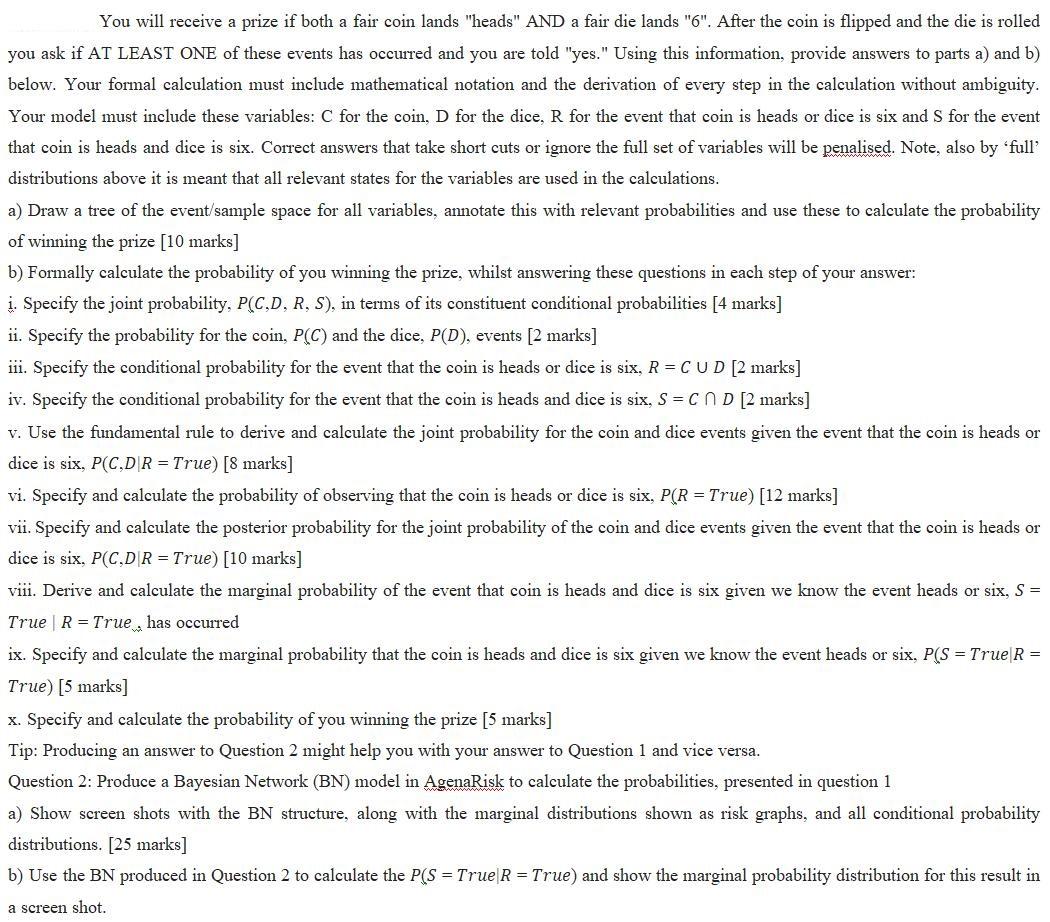Answered step by step
Verified Expert Solution
Question
1 Approved Answer
You will receive a prize if both a fair coin lands heads AND a fair die lands 6. After the coin is flipped and

You will receive a prize if both a fair coin lands "heads" AND a fair die lands "6". After the coin is flipped and the die is rolled you ask if AT LEAST ONE of these events has occurred and you are told "yes." Using this information, provide answers to parts a) and b) below. Your formal calculation must include mathematical notation and the derivation of every step in the calculation without ambiguity. Your model must include these variables: C for the coin, D for the dice, R for the event that coin is heads or dice is six and S for the event that coin is heads and dice is six. Correct answers that take short cuts or ignore the full set of variables will be penalised. Note, also by 'full' distributions above it is meant that all relevant states for the variables are used in the calculations. a) Draw a tree of the event/sample space for all variables, annotate this with relevant probabilities and use these to calculate the probability of winning the prize [10 marks] b) Formally calculate the probability of you winning the prize, whilst answering these questions in each step of your answer: i. Specify the joint probability, P(C,D, R, S), in terms of its constituent conditional probabilities [4 marks] ii. Specify the probability for the coin, P(C) and the dice, P(D), events [2 marks] iii. Specify the conditional probability for the event that the coin is heads or dice is six, R = CUD [2 marks] iv. Specify the conditional probability for the event that the coin is heads and dice is six, S = CND [2 marks] v. Use the fundamental rule to derive and calculate the joint probability for the coin and dice events given the event that the coin is heads or dice is six, P(C,DR = True) [8 marks] vi. Specify and calculate the probability of observing that the coin is heads or dice is six, P(R = True) [12 marks] vii. Specify and calculate the posterior probability for the joint probability of the coin and dice events given the event that the coin is heads or dice is six, P(C,DR = True) [10 marks] viii. Derive and calculate the marginal probability of the event that coin is heads and dice is six given we know the event heads or six, S = True R = True has occurred ix. Specify and calculate the marginal probability that the coin is heads and dice is six given we know the event heads or six, P(S = True R = True) [5 marks] x. Specify and calculate the probability of you winning the prize [5 marks] Tip: Producing an answer to Question 2 might help you with your answer to Question 1 and vice versa. Question 2: Produce a Bayesian Network (BN) model in AgenaRisk to calculate the probabilities, presented in question 1 a) Show screen shots with the BN structure, along with the marginal distributions shown as risk graphs, and all conditional probability distributions. [25 marks] b) Use the BN produced in Question 2 to calculate the P(S = True R = True) and show the marginal probability distribution for this result in a screen shot.
Step by Step Solution
★★★★★
3.46 Rating (153 Votes )
There are 3 Steps involved in it
Step: 1
Let C be the event that coin is heads and D be the event that die is landed on ...
Get Instant Access to Expert-Tailored Solutions
See step-by-step solutions with expert insights and AI powered tools for academic success
Step: 2

Step: 3

Ace Your Homework with AI
Get the answers you need in no time with our AI-driven, step-by-step assistance
Get Started


